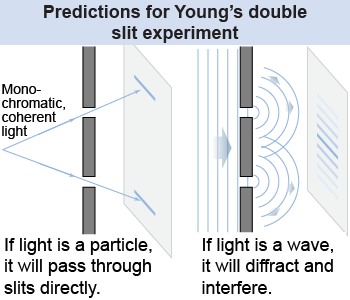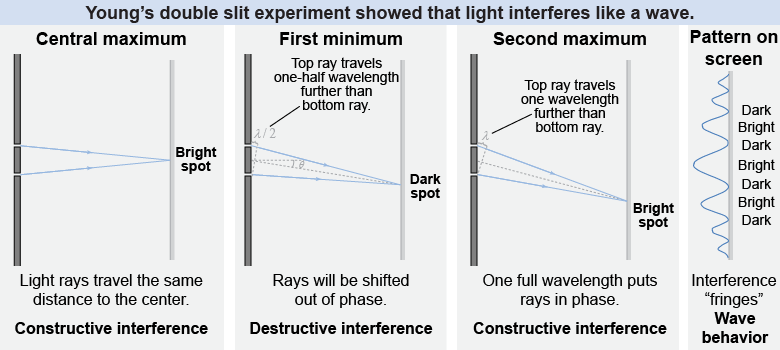|

| In 1801, the English physicist Thomas Young devised an experiment to determine whether light behaved as a wave or a particle. Up until then, physicists disagreed on the nature of light. Young’s insight was to pass monochromatic and coherent light through two narrow and closely spaced slits and then observe the pattern of the light on a screen. (Coherent light means that the waves are in phase with each other.) If light were composed of particles, then the particles would pass straight through the two slits and produce two bright lines of light on the screen. If light acted as a wave, then a distinctive interference pattern would be created by light waves passing through the slits. |

 |
In Young’s original experiment, he used sunlight as a light source. A mirror brought the light into his room and the light then passed through a small entrance hole. If the light source (the hole) weren’t small, interference would not be seen. (A large light source would act as many small sources; the fringes from one would overlap and blur out the fringes from another.) Young’s experiment can be reproduced by using a laser as the source of light, since it produces a small and coherent (in-phase) light source. 
|
Young found that light interfered with itself to produce a set of interference fringes on the screen. The brightest fringe was located between the slits, a location predicted by the wave model but where no particle could have reached. Interference is a behavior of waves, so Young’s experiment was the first direct confirmation that light can act as a wave. Young’s results were so convincing that 19th-century physicists assumed that light was a wave and thoroughly rejected the particle model until Albert Einstein proposed a theory that successfully explained the photoelectric effect. 
|

|
What causes the interference pattern? Light through both slits will travel an equal distance to a location on the screen halfway between the two slits, producing a central maximum. At a small angle θ from the center, light from one slit will have to travel an additional distance of λ/2, or one-half of a wavelength. That causes destructive interference, because the two waves are out of phase. At a larger angle, light from one slit will have to travel an additional distance of λ, or one full wavelength. That causes constructive interference, because the two waves are fully in phase. The pattern repeats as the angle increases, resulting in an interference pattern. 
 |
Each of the bright fringes in Young’s double slit experiment corresponds to a maximum in the interference pattern from constructive interference. The first maximum is located halfway between the two slits. The successive maxima are located at | | | d | = | separation between slits (m) | | θ | = | projection angle (degrees) | | λ | = | wavelength of light (m) | | m | = | order (0, 1, 2, ...) |
| Double slit interference
maxima |

|
| |
|

